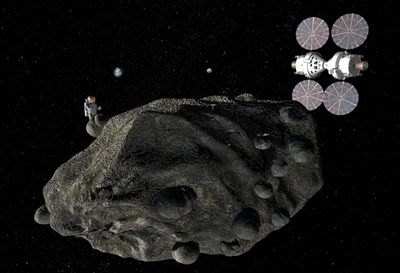The case for a human asteroid missionby Lou Friedman
|
| An achievement of a three- to six-month journey by astronauts to, around, on, and back from an asteroid would enhance popular interest in, and the perception of value of, space exploration. |
I apologize for stealing President Kennedy’s immortal words of May 25, 1961, and unabashedly adapting them to make my point that a human asteroid mission could and should be an inspiring goal to restore optimism and achievement to human space flight. Even more, it could reinvigorate American leadership in the best of ways, not with chauvinism, but by example and engagement of the whole world. Such leadership could promote international cooperation among the world’s space agencies to expand solar system exploration and development.
What has been missing from the debate about the future of space exploration is optimism and confidence. Even President Obama’s effort in this regard in Florida last April was too defensive and mired in politics.
An achievement of a three- to six-month journey by astronauts to, around, on, and back from an asteroid would enhance popular interest in, and the perception of value of, space exploration. The sight of astronauts gently bouncing on and off the asteroid, conducting experiments, and digging below the surface would be more engaging than the pale terrestrial “Dancing With the Stars.” What a boost it would give to our understanding about these strange objects, and what an education for our citizenry about a future which will certainly involve deflecting some object threatening our planet.
When The Planetary Society presented its Roadmap To Space at the National Press Club in Washington two years ago, one young journalist asked, “How will we feel if [because of this Roadmap], China beats us to the Moon?” Simultaneously and spontaneously several of us on the panel, and Buzz Aldrin in the audience, jumped to our feet and exploded, “We’ve already been first to the Moon!”
America can’t be first to the Moon again. No one can. But American leadership would be absolutely secure if we were leading an international mission in deep space beyond Earth orbit, while other nations (and perhaps even private companies) were getting their feet “wet” on the Moon.
The spirit of space—optimism for the future—has been sadly lacking in recent years. We are bogged down in small questions looking at our feet instead of using our minds to look at the stars. I have been pretty downbeat myself, as readers of some of my recent columns and articles have noticed. Perhaps the achievement last week of our friend and colleague, Elon Musk, with Falcon 9 and Dragon has provided some buoyancy to my view. Elon’s drive is not just to achieve Earth orbit, but also to help us one day reach Mars. His current achievement is just a milestone on the way. In one of his interviews last week Elon said he is developing this system so that NASA can focus on exploration and new achievements in human space flight.
| The rubble pile on which the present human space program perches could actually provide enough of a foundation on which to start building. |
Returning to my use of President Kennedy’s statement, I asserted my view that a human asteroid mission can be done within the decade; that is, by the end of 2020. This is faster than President Obama’s 2025 goal and faster than most folks in the space program feel is possible. I think it can be done within the budget guidelines laid out in the President’s proposed fiscal year 2011 budget (still to be passed by Congress). It’s a push, to be sure, but I was heartened by Lockheed Martin’s recent proposal that they could do such a mission with their Orion Crew Vehicle in that time period. If the established aerospace industry players would cooperate with the government and “NewSpace” companies for new human space achievements, I have no doubt that a 2020 timetable is possible. As SpaceX put it in a Twitter message a half hour after their successful mission: “A big thank you to NASA for their continued support! What an awesome partnership!”
The technical requirements of a human asteroid mission are big but straightforward. The mandate for the heavy-lift rocket needed for deep space missions is already in place. So is the crew vehicle, although it may need some kind of service module attachment. The commercial arrangements may even give us some competitive choices in this time period. The longer flight of an asteroid mission will need more supplies. We need to accelerate development of the crew life support capability required for the several-month interplanetary voyage, but we have already agreed to use the International Space Station for that training. International capabilities from the other spacefaring nations can keep the cost within today’s bounds. The rubble pile on which the present human space program perches could actually provide enough of a foundation on which to start building. But the endeavor needs an “architect” to lead it.
America and the world need their “can-do” spirit restored. A human asteroid mission is not the answer to all (or even most) of our problems, but like Apollo it can foster the spirit that enables much more to be accomplished. Do we have it in us?
